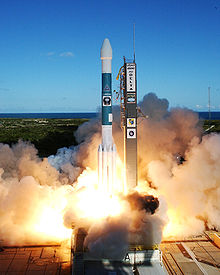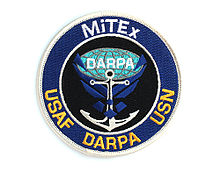- MiTEx
-
The Micro-satellite Technology Experiment (MiTEx) is a microsatellite-based mission launched into geosynchronous orbit June 21, 2006 aboard a Delta II rocket. The US Air Force described the mission as a "technology demonstration" for the Defense Advanced Research Projects Agency (DARPA), the U.S. Air Force and the U.S. Navy.[1]
MiTEx consists of three spacecraft; two inspection satellites, designated USA-187 and USA-188, and an experimental upper stage, designated USA-189.[2] The two inspection satellites were initially used to inspect each other, however they were later used to inspect DSP-23, a failed missile detection satellite, to find out why it stopped operating.[3]
Contents
Development
MiTEx was developed with funding from the Microsatellite Demonstration Science and Technology Experiment Program (MiDSTEP). Funding for MiDSTEP (and thus MiTEx) is allocated to DARPA through the "Space Programs and Technology" element of the United States Department of Defense (DoD) "Advanced Technology Development" budget item. DoD budget documents from February 2008 show costs of MiDSTEP in 2007 of US$8 million, in 2008 of $10 million, and in 2009 of $8 million.[4]. Dr. Owen C. Brown was the program manager for the design, integration, test, launch, and demonstration of MiTEx, while he was a program manager in the Tactical Technology Office (TTO) at DARPA [5].
Launch
The satellites were launched from Cape Canaveral Air Force Station Space Launch Complex 17 on 21 June 2006 at 21:34 UTC using a Delta II carrier rocket flying in a 7925-9.5 configuration. The two inspection satellites were lifted to geosynchronous orbit by a fourth stage of a new, experimental design. The stage was developed at the United States Naval Research Laboratory, and it is reportedly equipped with photovoltaic arrays for power.[3]
Mission
Because of their small dimensions (with a mass of 225 kg (500 lb) each), the satellites are hard to detect in their geosynchronous orbit, and thus could approach and examine other satellites without being noticed. After completion of their primary mission, the satellites were parked on opposite sites of Earth. During the 2nd week of 2009 the MiTEx satellites were commanded to approach DSP-23, which had failed two months earlier, and had started to drift by 1 deg East from its own parking position at 8.5deg East. The MiTEx satellite parked over the mid-Atlantic rendezvoused with DSP-23 around Dec 23, 2009, followed by the 2nd MiTEx satellite one week later. [3]
References
- ^ "Cape launches Delta II, MiTEx satellite". USAF. 2006-06-23. http://www.afspc.af.mil/news/story.asp?id=123022369.
- ^ "SPACEWARN Bulletin No. 632". NASA GSFC. 1 July 2006. http://nssdc.gsfc.nasa.gov/spacewarn/spx632.html.
- ^ a b c Covault, Craig (2009-01-14). "Secret inspection satellites boost space intelligence ops". Spaceflight Now. http://spaceflightnow.com/news/n0901/14dsp23/.
- ^ "RDT&E BUDGET ITEM JUSTIFICATION SHEET (R-2 Exhibit)". Defense Technical Information Center. February 2008. http://www.dtic.mil/descriptivesum/Y2009/DARPA/0603287E.pdf.
- ^ "Acquiring Space Systems in an Uncertain Future". November 2009. http://www.darpa.mil/tto/programs/systemf6/Papers/HighFrontier61.pdf.
External links
- http://pajamasmedia.com/richardfernandez/2009/01/15/and-now-micro-satellites/
- http://www.thespacereview.com/article/670/1
IMINT KH-1 CORONA · KH-2 CORONA · KH-3 CORONA · KH-4A CORONA · KH-4B CORONA · KH-5 ARGON · KH-6 LANYARD · KH-7 GAMBIT · KH-8 GAMBIT 3 · KH-9 HEXAGON · KH-10 DORIANLACROSSE ··SIGINT MASINT Primary missionSecondary missionResearch and
developmentPrimary missionMiTEx ·Secondary mission·Unknown USA number← 2005 · Orbital launches in 2006 · 2007 → New Horizons | Daichi | EchoStar X | Himawari 7 | Akari · Cute-1.7+APD | Arabsat-4A | SpainSat-1 · Hot Bird 7A | ST-5 | FalconSAT-2 | Soyuz TMA-8 | JCSAT-5A | COSMIC | Astra 1KR | Progress M-56 | EROS-B | Yaogan 1 | Kosmos 2420 | GOES 13 | Satmex 6 · Thaicom 5 | Resurs-DK1 | KazSat-1 | Galaxy 16 | USA-187 · USA-188 · USA-189 | Progress M-57 | Kosmos 2421 | USA-184 | STS-121 (MPLM) | Kwangmyŏngsŏng-2 | INSAT-4C | Genesis I | Kosmos 2422 | BelKA · Baumanets · PicPot · SACRED · ION · Rincon 1 · ICECube-1 · KUTESat Pathfinder · SEEDS · nCube-1 · HAUSAT-1 · MEROPE · CP-2 · AeroCube-1 · CP-1 · Mea Huaka'i · ICECube-2 | Arirang-2 | Hot Bird 8 | JCSAT-10 · Syracuse 3B | Koreasat 5 | Shijian 8 | STS-115 (ITS P3/4) | IGS-3A | Chinasat-22A | Kosmos 2423 | Soyuz TMA-9 | Hinode · HIT-SAT · SSSAT | USA-190 | DirecTV-9S · Optus D1 · LDREX | MetOp-A | Progress M-58 | Shijian 6C · Shijian 6D | STEREO | Sinosat-2 | XM-4 | USA-191 | Badr-4 | USA-192 | Feng Yun 2D | WildBlue 1 · AMC-18 | STS-116 (ITS P5 · SpaceHab LSM · ANDE-MAA · ANDE-FACL · RAFT1 · MARScom · MEPSI-2) | MEASAT-3 | USA-193 | TacSat-2 · GeneSat | Kiku 8 | SAR-Lupe 1 | Meridian 1 | Kosmos 2424 · Kosmos 2425 · Kosmos 2426 | COROTPayloads are separated by bullets ( · ), launches by pipes ( | ). Manned flights are indicated in bold text. Uncatalogued launch failures are listed in italics. Payloads deployed from other spacecraft are denoted in brackets. Categories:- Reconnaissance satellites of the United States
- Spacecraft
- Unmanned spacecraft
- Black projects
- 2006 in spaceflight
- Spacecraft launched by Delta II rockets
Wikimedia Foundation. 2010.


